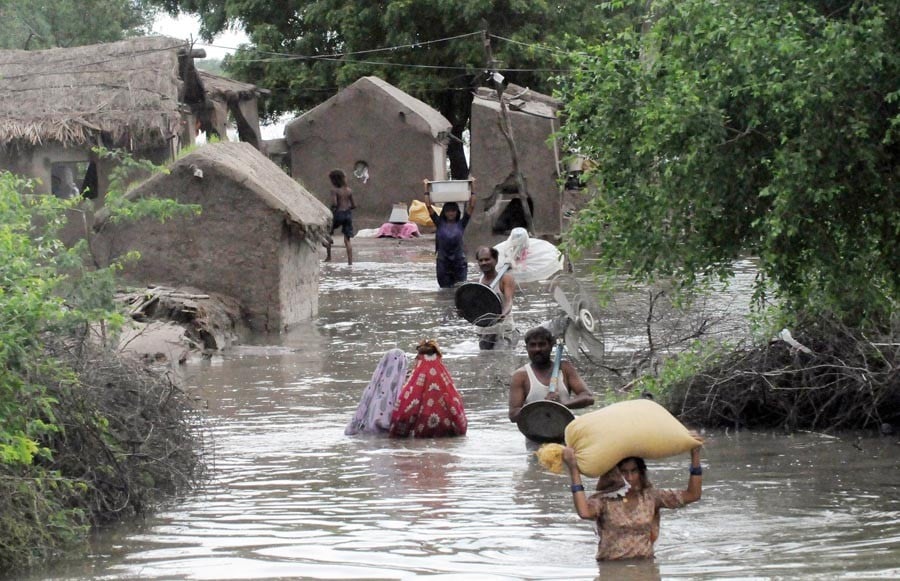
The provincial and federal governments must turn their attention and divert resources to plug loopholes in disaster management

Pakistan is in grip of disasters over the last some years. It is highly vulnerable to different disasters because it is located in the mountain ranges of Hindukush, Karakoram and Himalaya.
Against the backdrop of global warming glaciers are melting at quicker rate which worsens the hazard of floods. The northern region of Pakistan is prone to earthquakes, the flat region of Punjab and Sindh face the threat of floods, and some areas in Balochistan along with Cholistan and Thar are facing drought.
Pakistan has been facing floods or extraordinary monsoon rains from the last three years. There are reports that Pakistan will continue to face water-based-disasters in the years to come. Therefore, it is time that we objectively analyse the situation and take concrete measure for the upcoming monsoon season.
The point worth pondering is Pakistan has developed nuclear technology at the cost of compromising people’s basic rights. Our defence policy aims to protect its territory from assaults but has nothing to do to defend people against disasters. People inside our territory are dying out of hunger, poverty, illiteracy and triggering of hazards whereas a big portion of budget is spent in the name of national security leaving behind too little for education, health and disaster management. That Pakistan faced three disasters in a row is a result of state’s misplaced priorities, lack of institutionalised capacity and resources.
Devastation caused by floods has severely impacted the already shattered economy. Accumulated damage is a serious impediment to meet MDGs and other development targets. Multiple disasters have wiped out the development dividend made over the years. It has simply pushed Pakistan many years back. We must have short-term and long-term strategies in place to deal such menace in a well-prepared manner.
Areas of Sindh, Balochistan and Southern Punjab are traditionally vulnerable to floods due to faulty design of drains or other structural and non-structural gaps. It is a reality that people uprooted by floods are overshadowed by acute energy crises, terrorism and other political and economic turmoil. Their voice and visibility is nowhere in mainstream affairs. It is noted with pain that perhaps it will take another disaster to remind us to make them heard and feel their sorrows.
People are dying out of hunger, poverty, illiteracy and triggering of hazards whereas a big portion of budget is spent in the name of national security leaving behind too little for education, health and disaster management.
The major drawback in disaster management in Pakistan is that it is hugely tilted towards emergency response largely ignoring the prevention, preparedness and rehabilitation components. Emergency and relief services are provided on ad hoc basis and without human rights perspective: people’s fundamental rights ranging from safe drinking water to human dignity are widely violated; cross cutting issues of human rights, gender, disabled and religious and ethnic minorities are consistently ignored throughout the humanitarian operation. Scope of disaster management framework must be broadened. It must deal the problem with holistic approach.
There are multiple contributing factors to floods as observed in previous years. Some of them are settlement located at flood plains, gaps in flood protection infrastructure, inefficient early warning system, lack of Disaster Risk Reduction (DRR) programmes, inadequate institutional capacity and insufficient early response systems with government. Now is time to review these grey areas and undertake DRR efforts proactively rather than reactive steps.
In Pakistan, DRR’s integration into development is in early stages. There is a crying need to speed up the process keeping in view the risk level. DRR elements and strategies must be introduced and applied at all levels of society on war footing. First step for it is to create a wider understanding of underlying risk factors and possible actions at government and community levels. DRR mainly revolves around risk mapping, increasing the capacity to cope with disasters and minimising the vulnerability to hazards. But unfortunately, research and development in DRR is nominal and capacity to conduct hazard mapping and vulnerability assessment is very low.
More importantly, there is need to launch community based disaster risk reduction programmes because community is first to respond to disaster. It best knows the local hazards, risks, opportunities and constraints. Pilot projects focused on community based disaster risk reduction awareness must be introduced and replicated to other areas. Projects must aim to impart disaster reduction knowledge, skills and develop community-based emergency systems. Indigenous knowledge and a reliable community based early warning system must be prominent features of these projects.
In the end it may be concluded that the provincial and federal governments must turn their attention and divert resources and energies to plug loopholes well before time. The state needs to revisit its priorities and shift its paradigm from security state to welfare state. Moreover, there is much to learn from experience of Bangladesh. For example local government system can play a vital role for community based risk reduction strategies and practices. Capacity building programmes on DRR for government officials and communities must be initiated on urgent basis. Our media should also be vigilant: it needs to play a proactive role before, during and after disaster. Last but not the least allocation of funds towards DRR must be considered as investment and not as cost.